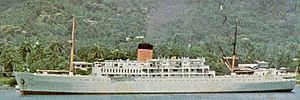TSS Golfito facts for kids
class="infobox " style="float: right; clear: right; width: 315px; border-spacing: 2px; text-align: left; font-size: 90%;"
| colspan="2" style="text-align: center; font-size: 90%; line-height: 1.5em;" | 
|} The TSS Golfito was a special kind of ship known as a banana boat. It was owned by Fyffes Line, a company that brought bananas to the UK. This ship was quite large, measuring about 448 feet (137 m) long. It could also travel at a good speed of 17.7 knots (32.8 km/h). The Golfito was designed to carry both passengers and a lot of fruit.
Contents
| History | |
|---|---|
| Name | Golfito |
| Owner | Elders and Fyffes |
| Operator | Elders and Fyffes |
| Route | Southampton or Avonmouth in England to Barbados, Trinidad and up to five ports in Jamaica (Kingston, Port Antonio, Montego Bay, Oracabessa and Bowdin) |
| Builder | Alexander Stephen and Sons |
| Launched | 6 October 1948 |
| Fate | Scrapped 1972 |
| General characteristics | |
| Type | Passenger-cargo ship/banana boat |
| Tonnage | 8,687 gross register tons (GRT) |
| Length | 448 feet (137 m) |
| Speed | 17.7 knots (32.8 km/h) |
Building and Retirement
The Golfito was built in 1949. A company called Alexander Stephen and Sons in Glasgow, Scotland, constructed the ship. After many years of service, the Golfito was taken apart for scrap in 1972. This happened at Faslane, a place in Scotland.
Ship Features
The Golfito had three decks for passengers. There were cabins for 94 first-class travelers. Passengers could also enjoy public rooms and open-air deck spaces. These areas were located in the middle of the ship.
Cargo Holds
The ship also had four large refrigerated cargo holds. Two were at the front and two were at the back. These special holds could carry a huge amount of bananas. They could hold about 140,000 banana stems, which is about 1,750 tons!
What the Ship Carried
The main job of the Golfito was to carry different types of goods. When it left England, it usually carried manufactured goods. These were items made in Britain. On its way back, the ship was filled with fresh bananas.
Travel Routes
The Golfito made long trips that lasted about four to five weeks. It would start its journey from Southampton or Avonmouth in England. Then, it would sail to the Caribbean.
Caribbean Stops
The ship would visit several islands in the Caribbean. These included Barbados and Trinidad. It also stopped at up to five ports in Jamaica. These ports were Kingston, Port Antonio, Montego Bay, Oracabessa, and Bowden. Bananas were loaded onto the ship during the cool night hours.
Sister Ship
In 1956, the Golfito got a sister ship named Camito. These two ships worked together. They provided a regular service every two weeks. This service connected the UK with the Caribbean islands.

